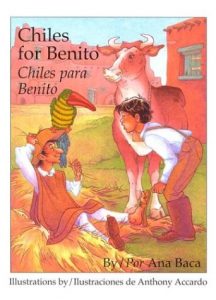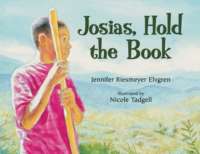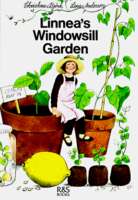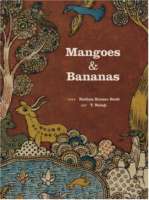 This charming bilingual fable explains the origins of the all-important chile Chiles ristras adorn the kitchen and dishes all over New Mexico. In the winter, when the nights grow longer and the winds blow stronger, chiles season meats and stews bringing New Mexico spice to every hungry taste bud. But chiles didn’t always grow in New Mexico, and Ana Baca tells a special fable about Benito and the chiles that crawled all over his family’s simple homestead. Benito’s mother sends him to the country fair in the hopes of their cow winning the first place prize. This would give them money to buy some seeds for the crop, but the cow misbehaves and they must leave the fair. Suddenly, Benito is stopped by a mysterious man with a peculiar bird on his shoulder. The man offers Benito some powerful seeds in exchange for his cow, which Benito quickly accepts. But when only uncontrollable weeds grow from the ground, Benito begins to feel foolish. The neighboring farmers begin to complain that the relentless weeds are killing their crop. How will the community survive? Will the rapidly growing weeds ever bear fruit for Benito?
This charming bilingual fable explains the origins of the all-important chile Chiles ristras adorn the kitchen and dishes all over New Mexico. In the winter, when the nights grow longer and the winds blow stronger, chiles season meats and stews bringing New Mexico spice to every hungry taste bud. But chiles didn’t always grow in New Mexico, and Ana Baca tells a special fable about Benito and the chiles that crawled all over his family’s simple homestead. Benito’s mother sends him to the country fair in the hopes of their cow winning the first place prize. This would give them money to buy some seeds for the crop, but the cow misbehaves and they must leave the fair. Suddenly, Benito is stopped by a mysterious man with a peculiar bird on his shoulder. The man offers Benito some powerful seeds in exchange for his cow, which Benito quickly accepts. But when only uncontrollable weeds grow from the ground, Benito begins to feel foolish. The neighboring farmers begin to complain that the relentless weeds are killing their crop. How will the community survive? Will the rapidly growing weeds ever bear fruit for Benito?
Gardening
Sunflowers / Girasoles
After helping her grandfather plant squash, onions, carrots, cabbage, and other vegetables that her mother uses in soups and salsas, seven-year-old Marisol plants sunflower seeds in her neighbors’ yards, and weeks later, everyone gets to enjoy the fruits of Marisol’s labor.
”My name is Marisol. I’m seven years old. This spring, I helped my grandfather make a garden.” First, Marisol and her grandfather had to prepare the ground. They pulled out the old plants and weeds. They mixed up all the dirt ”to make it soft.” Then it was time to plant the seeds. They planted seeds to grow the vegetables Mama uses in soup squash, onions, carrots, and cabbage. They planted seeds to grow the things she needs to make salsa garlic, tomatoes, cilantro, and chili peppers. They planted mint for Abuela’s tea. They planted watermelon seeds for Marisol and her brother. And for Grandad, they planted sunflower seeds because their ”big black eyes with long yellow eyelashes” make him happy. And he likes to eat the seeds! One day, Marisol’s grandfather gives her a small bag of sunflower seeds, but instead of eating them she plants them here and there one in the corner of Mrs. Sosa’s yard, another in Mr. Binh’s yard. In fact, as she walks to school, she plants seeds in the corners of all the yards she passes. And she plants the last three seeds in the playground at school. As the days pass, sometimes it’s rainy and sometimes it’s sunny. Finally, one bright day, Marisol’s sunflower surprise shines a bit of happiness all around. The tender relationship between grandparent and grandchild is illuminated in this children’s book by author Gwendolyn Zepeda with warm illustrations by Alisha Gambino. Children ages 3-7 will sow and reap ideas of their own about ways to share a little joy, just as Marisol does with sunflowers.
The Boys of San Joaquin
Paolo calls Rufus “a Mack truck with no one driving.” Rufus is the O’Neil family dog, and he shows up one morning with part of a twenty-dollar bill in his teeth.Paolo, age twelve, figures that there must be more where that bill came from, and since his cousin Billy needs to repair a bent wheel on his bike, there’s a reason for looking. He, Georgie, and Billy end up in the monsignor’s garden behind the Cathedral of San Joaquin, but it’s not exactly treasure they find, it’s a hand that shoots out of the undergrowth to grab Paolo’s neck. The search for the stash leads the boys — sometimes scared spitless — on many a byway around Orange Grove City, California, in the summer of 1951. And onto the byway of conscience.”Suppose you found a treasure. Couldn’t you keep it?” Paolo asks his uncle. “I mean, say you know who it belongs to, and they probably need it….But when you find it, nobody has it. Isn’t nobody’s property in particular, then,” he reasons. “Well, maybe somebody has it, but it isn’t theirs. It would be yours, wouldn’t it?”No answer. “How in the heck is a guy supposed to be somebody in this world without any money?”
Josias, Hold the Book

Every Morning Josias is hard at work in the family’s garden under the hot Haitian sun. And every morning he sees his friend Chrislove walk to school. When will you join us to hold the book? asks Chrislove. But Josias has a garden to tend and no time to learn to read and write, especially now that the garden is failing. Josias can’t figure out why the beans aren’t growing. Without beans, there may not be enough food for his family. He tries giving the beans more water. He tries working more fertilizer into the soil. Still, the garden shows no sign of life. One morning, when Chrislove asks again when his friend plans to come to school, Josias wonders if a book might hold the solution to his problem.
Featured in Volume I, Issue 2 of WOW Review.
Linnea’s Windowsill Garden (Linnea Books)

In this book, she takes you on a tour of her indoor garden. She tells you about her orange tree (and plantable pits and seeds, including melons, tomatoes, and grapes); she shows you how to take a cutting from a Busy Lizzie and how to trim an avocado plant.
And she teaches you what keeps plants satisfied: the art of watering properly (plants don’t like standing with their feet in water) and fertilizing. And what to do when plants are attacked by whiteflies or other nasty bugs.
Linnea also makes garden-cress cheese (from homegrown cress, of course); discusses the pleasures and possible pitfalls of growing an amaryllis; and writes a plant newspaper, The Green Gazette.
Linnea’s Windowsill Garden will informs and inspire anyone who wants to grow an indoor garden of their own.
Mangoes & Bananas

Mangoes and Bananas tells the tale of Kanchil the mouse deer and Monyet the monkey — two friends who plant a garden together. But when the trees bear fruit, Monyet begins to eat everything himself. Kanchil has to act fast if he is to get anything at all. Combining folk art with folk tale, this book reflects the warmth and richness of both traditions.
